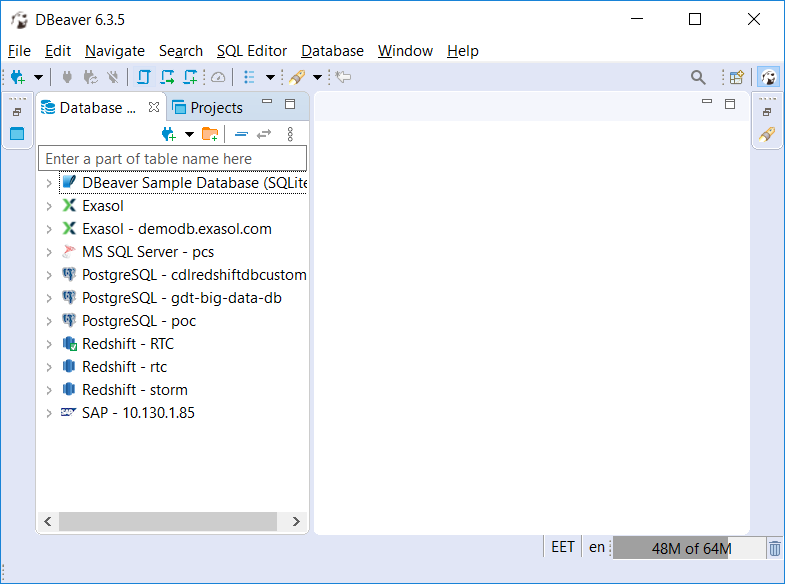DBeaver is one of the best free SQL IDE’s I’ve seen. It has a great UI, it’s fast, and the Projects feature is a helpful way of organising your files and related information. If you’re considering using DBeaver for your SQL work, you can’t go wrong with this choice. DBeaver and Microsoft SQL Server Management Studio can be primarily classified as 'Database' tools. DBeaver is an open source tool with 9.88K GitHub stars and 835 GitHub forks. Here's a link to DBeaver's open source repository on GitHub. Select new connection type, in your case, MS SQL Server - Microsoft Driver - Next. When I did my config, the JDBC URL, Port, and Host were already filled out. So, what you'll be just doing here is to enter your User name and Password for SQL Server. Then, click Test Connection. You'll be prompted to.
Light and friendly interface for your datasources

For your environment
SQL and NoSQL support
MySQL, PostgreSQL, Oracle, SQL Server, MongoDB, SQLite, AWS datasources and more others.

AWS ready
Available in AWS Marketplace.
Connect to AWS RDS, Redshift and Dynamo DB in a few clicks.
Docker pack
Official Docker container on Docker hub.
Launch with one command.
Choose your CloudBeaver
- CloudBeaver is available on AWS marketplaceCloudBeaver Enterprise has been published on AWS marketplace. You will be surprised how easy CloudBeaver can be integrated to Read more…
- CloudBeaver documentationDo you know that you can download the CloudBeaver documentation as a PDF file on the Docs page on Read more…
Dbeaver Sql Server
Our other products
DBeaver Enterprise Edition
DBeaver EE is a powerful desktop database client for data management, analysis and administration. It supports almost all existing databases: SQL, BigData, Analytical and more others.
DBeaver Community Edition

DBeaver CE is a popular open-source desktop application for working with SQL-databases. It supports all popular databases: MySQL, PostgreSQL, SQLite, Oracle, DB2, SQL Server and others.
The CData JDBC Driver for SQL Analysis Services implements JDBC standards that enable third-party tools to interoperate, from wizards in IDEs to business intelligence tools. This article shows how to connect to SQL Analysis Services data with wizards in DBeaver and browse data in the DBeaver GUI.
Sql 2016 R Tutorial
Create a JDBC Data Source for SQL Analysis Services Data
Follow the steps below to load the driver JAR in DBeaver.
- Open the DBeaver application and, in the Databases menu, select the Driver Manager option. Click New to open the Create New Driver form.
- In the Driver Name box, enter a user-friendly name for the driver.
- To add the .jar, click Add File.
- In the create new driver dialog that appears, select the cdata.jdbc.ssas.jar file, located in the lib subfolder of the installation directory.
- Click the Find Class button and select the SSASDriver class from the results. This will automatically fill the Class Name field at the top of the form. The class name for the driver is cdata.jdbc.ssas.SSASDriver.
- Add jdbc:ssas: in the URL Template field.
What Is Sql Server
Create a Connection to SQL Analysis Services Data
Install Local Sql Server Instance
Follow the steps below to add credentials and other required connection properties.
- In the Databases menu, click New Connection.
- In the Create new connection wizard that results, select the driver.
- On the next page of the wizard, click the driver properties tab.
Enter values for authentication credentials and other properties required to connect to SQL Analysis Services.
To connect, provide authentication and set the Url property to a valid SQL Server Analysis Services endpoint. You can connect to SQL Server Analysis Services instances hosted over HTTP with XMLA access. See the Microsoft documentation to configure HTTP access to SQL Server Analysis Services.
To secure connections and authenticate, set the corresponding connection properties, below. The data provider supports the major authentication schemes, including HTTP and Windows, as well as SSL/TLS.
- HTTP Authentication
Set AuthScheme to 'Basic' or 'Digest' and set User and Password. Specify other authentication values in CustomHeaders.
- Windows (NTLM)
Set the Windows User and Password and set AuthScheme to 'NTLM'.
- Kerberos and Kerberos Delegation
To authenticate with Kerberos, set AuthScheme to NEGOTIATE. To use Kerberos delegation, set AuthScheme to KERBEROSDELEGATION. If needed, provide the User, Password, and KerberosSPN. By default, the data provider attempts to communicate with the SPN at the specified Url.
- SSL/TLS:
By default, the data provider attempts to negotiate SSL/TLS by checking the server's certificate against the system's trusted certificate store. To specify another certificate, see the SSLServerCert property for the available formats.
You can then access any cube as a relational table: When you connect the data provider retrieves SSAS metadata and dynamically updates the table schemas. Instead of retrieving metadata every connection, you can set the CacheLocation property to automatically cache to a simple file-based store.
See the Getting Started section of the CData documentation, under Retrieving Analysis Services Data, to execute SQL-92 queries to the cubes.
Built-in Connection String Designer
For assistance in constructing the JDBC URL, use the connection string designer built into the SQL Analysis Services JDBC Driver. Either double-click the JAR file or execute the jar file from the command-line.
java -jar cdata.jdbc.ssas.jarFill in the connection properties and copy the connection string to the clipboard.
Below is a typical connection string:
jdbc:ssas:User=myuseraccount;Password=mypassword;URL=http://localhost/OLAP/msmdpump.dll;- HTTP Authentication
Query SQL Analysis Services Data
You can now query information from the tables exposed by the connection: Right-click a Table and then click Edit Table. The data is available on the Data tab.

